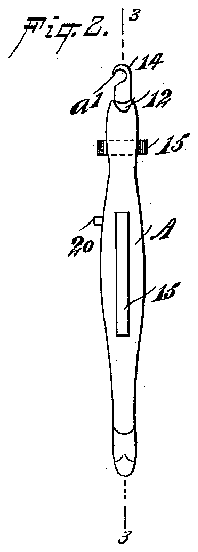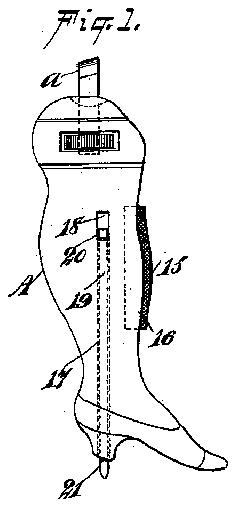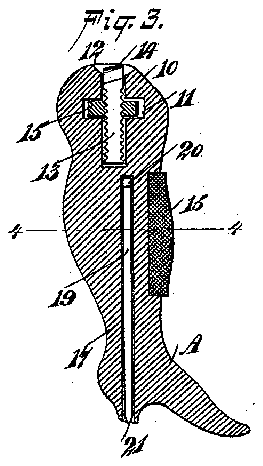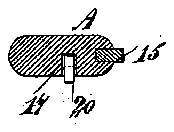



- 3line
- 4line
- 11opening
- 12cavity
- 14knife
- 17bore
- 20head
Description
3.5mm.' MANICURE IMPLEMENT.
(No Model.)
Patented sept. 22, 1896.
d /lvvE/vron Arm/m6 UNITED STATES YPATETW OFFICE.'y
RICHARD HART, OF PITTSBURG, PENNSYLVANIA, ASSIGNOR TO I-IIMSELF AND JAMES S. MONTGOMERY, OF SAME PLACE.
MANICURE IMPLEIVIIENT.`
SPECIFICATION forming part of Letters Patent No. 568,249, dated September 22, 1896.
Application filed January 31 1896. Serial No. 574,237. (No model.)
T0 all4 whom t may concern,.-
Be it known that I, RICHARD E. HART, of Pittsburg, in the county of Allegheny and State of Pennsylvania, have invented a new and Improved Manicure Implement, of which the following is a full, clear, and exact description.
My invention relates to implements especially adapted for manicure practice; and the object of the invention is to combine in one handle or support a knife of peculiar construction being especially adapted for cutting the nails and so formed that the nails may be readily trimmed without danger of lacerating the flesh of the fingers, and, furthermore, to provide an adjustment for the knife whereby it may be carried entirely within the handle, holder, or other support or carried out therefrom a predetermined distance.
A further object of the invention is to provide a nail-cleaner adjustably located in the handle or holder and capable of being entirely concealed therein or carried out therefrom a suitable distance.
A further object of the invention is to provide the said holder or handle with a nail-file, soplaced that it will be readily accessible and may be advantageously used.
The invention consists in the novel construction and combination of the several parts, as will be hereinafter fully set forth, and pointed out in the claim.
Reference is to be had to the accompanying drawings, forming a part of this specication, in which similar characters of reference indicate corresponding parts in all the figures.
Figure 1 is a side elevation of the improved implement, illustrating the nail-cleaner and knife in position for use. Fig. 2 is a front edge view of the implement. Fig. 3 is a longitudinal vertical section taken substantially on the line 3 3 of Fig. 2, and Fig. 4is a transverse section taken practically on the line 4 4 of Fig. 3.
In carrying out the invention the handle or holder A may be given any desired shape and may be made of any approved material. Preferably in the upper end of the holder a vertical bore or recess lO is formed, and in the sides of the holder or handle an opening 11 is made, extending through from side to side and communicating with the aforesaid bore or recess 10, and preferably the upper end of the handle or holder is rounded off or rendered somewhat cylindrical, and is provided with a thread to receive a nut 15, located in 6o the opening 11 of the handle or holder, and this nut is preferably circular and is milled at its edge, and, furthermore, the nut is of such size that it will extend outward beyond the sidesof the handle or holder, so that it may be engaged by the thumb and fingers of the hand for the purpose of rotating said nut. As the nut is turned, it being confined within the openin g 11, the shank of the knife will be carried upward or downward to bring the 7o knife 14 either above or below the end of the handle or holder.
The knife 14 consists of a blade preferably integral with the shank, and which is of hook-like formation, being substantially circular, and the said blade is tapered longitudinally or in direction of the edges of the holder or handle, as shown in Figs. 1 and 3, the lower end of the knife being'sharpened to form a cutting edge, and preferably the side 8o edge of the knife is also sharpened, thereby providing two cutting-surfaces, an end cutting-surface a and a side cutting-surface a; but only one cutting-surface may be used if deemed desirable. of the knife is made to face the cavity 12 in the end of the handle, whereby the fingernail maybe guided to the blade or knife by means of the said cavity, especially when the end cutting-surface of the knife is used, and 9o said surface is the principal one.
Owing to the peculiar formation of the blade or knife, a finger-nail may be smoothly and expeditiously trimmed without danger of lacerating the iesh of the finger, since the 95 back portion of the blade, which is preferably smooth, will be in engagement with the flesh during the process of cutting.
A file 15 is secured, preferably, in the front edge of the handle or holder, although it roo may be otherwise located, and the surface of the holder or handle adjacent to the sides of The end cutting-surface l the file are curved as shown at 16 in Fig. 1, although said edges may be straight if desired.
A longitudinal bore 17 is inade in the opposite end of the handle to that at which the knife is placed, and the said bore is usually made to extend seine distance Within the said handle, as shown in Fig. An opening is made in a side of the handle or holder co1n inunicating with the inner end of the bore. A rod 10 is held to slide in the bore 17 being provided With a head 20, extending outward through .the side opening 1S in the handle or holder, While the lower end 2l of the said rod is beveled and also preferably slightly sharpened and pointed to forni a nail-cleaner. Then the nail-cleaner is not required, it is drawn Within the handle or holder by sliding the head 2O thereof in an inwardly direction, and when the said cleaner is needed the said head is carried in an outwardly direction, exposing the cleaner suiliciently to enable the operator to readily apply it to the nails.
Having thus described my invention, I claim as new and desire to secure by Letters Patent- A manicure instrument, comprising a handle or main portion formed with a passage terminating at its outer end in a recess, and a knife movable in said recess, the knife having a square end curved sidewise and having said square end edged and also having one side edged at its curved portion, the edged parts of the knife being juxtaposed to the recess so that the recess will guide the part being cut, substantially as described.
RICHARD HART. lVitnesses:
JOHN MoANDREWs, GEO. REGELMAND.